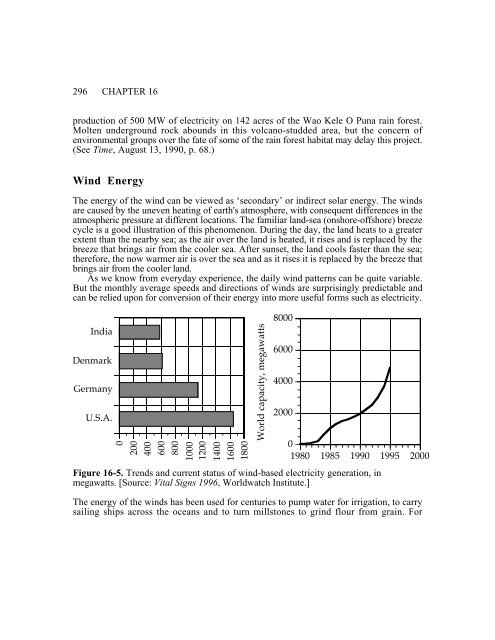Chapter 16 WATER, WIND, BIOMASS AND GEOTHERMAL ENERGY
Chapter 16 WATER, WIND, BIOMASS AND GEOTHERMAL ENERGY
Chapter 16 WATER, WIND, BIOMASS AND GEOTHERMAL ENERGY
You also want an ePaper? Increase the reach of your titles
YUMPU automatically turns print PDFs into web optimized ePapers that Google loves.
296 CHAPTER <strong>16</strong><br />
production of 500 MW of electricity on 142 acres of the Wao Kele O Puna rain forest.<br />
Molten underground rock abounds in this volcano-studded area, but the concern of<br />
environmental groups over the fate of some of the rain forest habitat may delay this project.<br />
(See Time, August 13, 1990, p. 68.)<br />
Wind Energy<br />
The energy of the wind can be viewed as ‘secondary’ or indirect solar energy. The winds<br />
are caused by the uneven heating of earth's atmosphere, with consequent differences in the<br />
atmospheric pressure at different locations. The familiar land-sea (onshore-offshore) breeze<br />
cycle is a good illustration of this phenomenon. During the day, the land heats to a greater<br />
extent than the nearby sea; as the air over the land is heated, it rises and is replaced by the<br />
breeze that brings air from the cooler sea. After sunset, the land cools faster than the sea;<br />
therefore, the now warmer air is over the sea and as it rises it is replaced by the breeze that<br />
brings air from the cooler land.<br />
As we know from everyday experience, the daily wind patterns can be quite variable.<br />
But the monthly average speeds and directions of winds are surprisingly predictable and<br />
can be relied upon for conversion of their energy into more useful forms such as electricity.<br />
India<br />
Denmark<br />
Germany<br />
U.S.A.<br />
0<br />
200<br />
400<br />
600<br />
800<br />
1000<br />
1200<br />
1400<br />
<strong>16</strong>00<br />
1800<br />
World capacity, megawatts<br />
8000<br />
6000<br />
4000<br />
2000<br />
0<br />
1980 1985 1990 1995 2000<br />
Figure <strong>16</strong>-5. Trends and current status of wind-based electricity generation, in<br />
megawatts. [Source: Vital Signs 1996, Worldwatch Institute.]<br />
The energy of the winds has been used for centuries to pump water for irrigation, to carry<br />
sailing ships across the oceans and to turn millstones to grind flour from grain. For
















